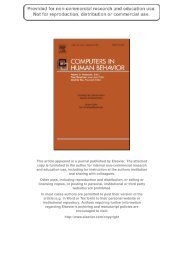Varnhagen.pdf
You also want an ePaper? Increase the reach of your titles
YUMPU automatically turns print PDFs into web optimized ePapers that Google loves.
728 C. K. <strong>Varnhagen</strong> et al.<br />
We also found few typographical errors and misspellings in our corpus. A<br />
paired samples t-test revealed no statistically significant differences between<br />
misspellings and typographical errors. Misspellings were generally phonetic<br />
misspellings of words that are not likely of high enough frequency to merit a short<br />
cut of their own (e.g., actualy, awsome). Typographical errors included common<br />
right-left hand errors, such a knwo (knwo is such a common typographical error<br />
that some word processing programs will automatically correct for it), letter<br />
reversals (e.g., carzy for crazy), and extra letters that are adjacent on the keyboard<br />
(e.g. whatds).<br />
We found many individual differences in use of new language. For example, one<br />
participant expressed shock with pragmatic lengthening (WHAT), another used<br />
pragmatic lengthening (whaaaat), and another added extra punctuation (what!!!!!).<br />
Similarly, one participant finished a conversation with word combination (gotta go),<br />
another used an acronym (g2g), and another used a number word (got 2 go). These<br />
individual differences led to few correlations between different types of new<br />
language use, namely between abbreviations and use of word combinations,<br />
r(38) = 0.61, p \ 0.001, and between typographical errors and use of upper case to<br />
express emotion, r(38) = 0.51, p \ 0.005. On the other hand, these correlations<br />
make intuitive sense: both abbreviations (e.g., em for them or cause for because) and<br />
word combinations (e.g., gonna for going to or kinda for kind of) shorten common<br />
words and speed up typing. Use of upper case requires holding down the shift key or<br />
setting and unsetting the ‘‘Caps Lock’’ key and can easily lead to typographical<br />
errors.<br />
Effects of gender, age, and spelling on new language use<br />
Because age and spelling ability as measured by standardized scores on the WRAT<br />
Spelling subtest are continuous variables, we conducted multiple regression<br />
analyses, as opposed to analysis of variance, to examine the effects of gender,<br />
age, and spelling ability on new language use. Because we were interested in<br />
potential interactions among these independent variable, we also used centered<br />
variables to allow us to include interaction effects. Centering variables controls for<br />
issues with multicolinearity between the variable and their interactions and allows<br />
for easier interpretation of the regression coefficients (Aiken & West, 1991). As<br />
well, because we had no a priori expectations about how all the variables might or<br />
might not fit in the model, we conducted stepwise analyses. Identical to analysis of<br />
variance, the weightings and statistical significance of the independent variables and<br />
their interactions in the stepwise multiple regressions alerted us to the importance of<br />
these variables. We then decomposed the statistically significant interaction effects<br />
using correlational analyses.<br />
We conducted a total of 15 stepwise multiple regressions, considering total new<br />
language use and each category of new language use as the dependent variables. We<br />
obtained statistically significant results for total new language use, use of<br />
abbreviations, and misspellings.<br />
Considering first total new language use, we found a statistically significant effect<br />
of gender and an interaction between gender and spelling ability, F(2, 37) = 7.05,<br />
123
















